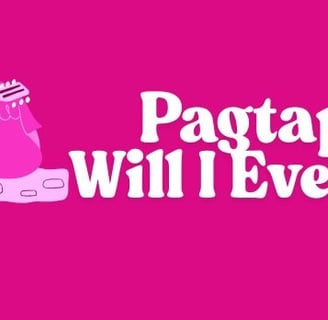Johnoy and Kakoy's Pagtatapat and Will I Waltz
old, old, old music writing.
MUSICPUBLICATIONS
Anina Abola (who knows how old)
4/17/20254 min read


Originally published in pulse.ph (which no longer exists)
I wrote this at least 15 years ago for an online publication, and brought it out of the baul because I saw that Johnoy Danao was celebrating 25 years in music. Apart from just the music itself which is worth listening to, It was nice visiting this version of Anina. She felt like she was a writer, I think.
Perhaps because they came to me almost-bootleg, I initially viewed the songs of Kakoy & Johnoy (Johnoy & Kakoy) as objects of utter sincerity. This, after all, is how exactly love songs should be shared: either from that high school love who still thinks that mix tapes are cool, or, really, from a sibling gushing (like a head wound). You can approach this method of music acquisition in the same vein as the dying art of the love letter, or just holding someone’s hand without the fireworks, or the self-reflexive, ironic, wink-wink moment that most people think love is all about, or even grand cinematic spectacle (perhaps with the music swelling).
The jaunty strumming that introduces “Pagtatapat” tells you that you’re in for a good story. And it is one with which most people are familiar. The seemingly belated entry of the voice cues you into the excited and nervous energy that powers the song: yes, the persona is in love, madly in love, and he’s mustering up the courage (with each guitar strum) to finally say so. With the earnestness of an old black-and-white Mickey Mouse flick, the narrative portrays scene after scene of hesitation (“nagsasalita sa harap ng salamin”) and textbook juvenile anxiety (“natutunaw sa lagkit ng kanyang tinig”). And, along with these, the arrangement helps build the tension, slowly shifting from jangly ragtime rhythms to drawn-out notes and harmonies that sound as though pleading for love to be returned, and also syncopated by the clarinet’s distractions, as though the clarinet itself were overwhelmed by the possibilities of how it could just be so sweet.
In reality, however, it is not the actual revelation in the narrative that serves as the climax, when the music actually does swell; it is the pleading of the persona to be rid of misery (“Ayoko nang umasa pa./Kung ayaw mo sa akin,/sabihin mo na”). It is as if our ardent suitor sees the reality in front of him, and it is, sadly, not couple-dom. He then comforts himself with the thought of at least having professed love, over and over, knowing that perhaps only the gods’ favor will give him his heart’s desire. And then the voice gives way because only music could fill that uncertainty of waiting for someone to say yes.
I can only imagine how “Pagtatapat” would be performed in settings where it could be prefaced with the actual story, but without that, I’ll take my cues from the song and its vaudevillian shades. You can just hear the silent laugh track, because unrequited love is funny, sad, and unrelenting—at least until the giant hook pulls you off the rickety wooden stage.
Now, “Will I Ever Waltz” is from the same ilk, and it’s about how love changes in the rocky terrain of uncertainty now at the story’s denouement (do we not all have one love story after all?). This song is tinged with simple and poignant lyricism, and even lyric in the poetic sense, a plea to an unnamed you. It is wry without bearing the coarse irony that a lot of self-conscious indie musicians wield like baby balisongs.
Apart from the furtive plucking that informs much of the song, the easy label of “sentimental folksy ditty” is obliterated by the plainspoken nature of the song’s lyrics (as well as its certain and masterful turns of musical phrase.) Yes, it is lyric and heartbreakingly confessional but without annoying, cloying solipsism. You know that somehow, the voice (or the persona) is singing alone, working out in his head what comes next before he answers an inevitable question. There is an infinite stretch of time that comes before cleaving (yes, to cleave as both “to separate” and “to hold fast faithfully”), and when a song can give you that much space in your head, then you know it is utterance, a strong and honest utterance of such fragile uncertainty. The dramatic situation of a lover trying to discern uncertain fidelity or certain separation is told in recognizable clichés (this is a love song after all). But the surprising use of such idioms (“No comic relief in this novel romance”) gives you critical leeway, as great songs do, to say that this is your song as well as it is his.
Wishing that I had more language and sense to speak of the music so eloquently, all I can say is that the music itself is lyrical. It moves as certain and as uncertainly as the lyrics do—as if in disbelief to find that the notes that do come, fit with what came before it and what came before that. Because this is what great songs must do: give you a parenthesis of coherence in a time where incongruity is default. And when words give way to the unsayable? Yes, there are no words but lo, there is song.
Is it kosher to say that folk is graceful? Because that is exactly what it is. It is this same artful dissonance that resonates in the title—though the use of the word waltz may refer to the song’s structure—it is also a conjecture into the nature of love. Both songs are.
And until we all finally “secure this insecure love of yours” then by Bathala, there should be music. And please, please, please, God, let it be from them.
